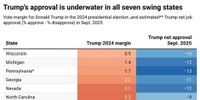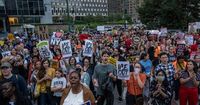President Donald Trump’s standing with the American public has seen subtle but notable shifts in recent weeks, as two major national polls released at the close of September 2025 paint a complex picture of approval, trust, and concern across the political spectrum. The surveys, conducted by The New York Times/Siena University and The Economist/YouGov, offer a snapshot of the mood in the United States as the nation faces economic uncertainty, political division, and the looming threat of a government shutdown.
According to the New York Times/Siena University poll, President Trump’s approval rating ticked up by one point to 43 percent among registered voters. The poll, conducted from September 22 to 27 among 1,313 registered voters, shows that Trump’s net approval stands at 43 percent, while his net disapproval remains at 54 percent. Notably, 29 percent of respondents said they “strongly approve” of the president’s performance, while 46 percent “strongly disapprove.” These figures are statistically similar to the previous poll conducted in April, which found 42 percent approval and 54 percent disapproval, indicating a relatively stable—if polarized—political environment.
Among independent voters, however, there has been a more pronounced shift. Approval among independents rose from 29 percent in April to 35 percent in the most recent survey, while disapproval dropped from 66 percent to 61 percent. This movement suggests that Trump is making some inroads with voters who do not identify with either major party, a trend echoed in the Economist/YouGov poll. That survey, conducted between September 26 and 29 among 1,656 U.S. adults, found Trump’s net approval rating rebounding from a record low of -18 two weeks prior to -14. Among Americans who do not align with the Democratic or Republican parties, approval rose from 19 percent to 26 percent, and disapproval fell from 69 percent to 56 percent within two weeks. While Trump’s numbers remain underwater with this group, the improvement is notable—especially given the volatility of public opinion in recent months.
When it comes to partisan breakdowns, the Times/Siena poll revealed that approval among Democrats dropped by 2 points to just 4 percent, while Republican approval increased by 3 points to a striking 89 percent. These numbers reflect the entrenched polarization that has come to define American politics. Meanwhile, the Economist/YouGov poll found that 41 percent of Americans view Trump favorably, while 54 percent view him unfavorably—almost identical to the Siena findings, underscoring the consistency of Trump’s favorability ratings across different methodologies.
On the economic front, perceptions of Trump’s impact have shifted in a direction that may offer the White House some encouragement. In the Times/Siena poll, 32 percent of respondents said Trump has made the economy better since taking office—a significant jump from the 21 percent who said so in April. Conversely, the share who believe Trump has made the economy worse dropped by 5 points to 45 percent. The share of voters who say Trump’s policies have helped them personally also increased, rising from 17 percent in April to 26 percent in the latest poll, while those reporting no noticeable difference declined to 40 percent. These figures suggest that, at least for a segment of the population, Trump’s economic messaging may be resonating more strongly than it did earlier in the year.
Yet, the broader economic outlook remains grim for many Americans. The Economist/YouGov poll found that only 19 percent of Americans believe the economy is getting better, while a majority—53 percent—say it is getting worse. Among Republicans, 41 percent say the economy is improving, but 22 percent now say it is worsening, matching the lowest net positive economic view among Republicans during Trump’s second term. This growing pessimism, even within Trump’s own party, highlights the challenges facing the administration as it seeks to bolster confidence ahead of potential electoral battles.
Political gridlock and the specter of a government shutdown are also weighing heavily on the national psyche. According to The Economist/YouGov, 63 percent of Americans believe a government shutdown is very or somewhat likely to occur this year, with majorities of both Democrats (74 percent) and Republicans (55 percent) expressing this concern. If a shutdown does happen in the coming weeks, 33 percent of respondents say Republicans would be most responsible, 27 percent would blame Democrats, and 31 percent would assign equal blame to both parties. A clear majority—63 percent—prefer that lawmakers compromise to reach a budget agreement, even if it means sacrificing some priorities, rather than risk a shutdown. Despite the partisan divide, this consensus on compromise is striking, though whether it translates into legislative action remains to be seen.
The potential impact of a shutdown is not lost on the public. Forty-five percent of Americans say they would be personally affected by a shutdown to some degree, with concerns ranging from furloughs of non-essential government workers (expected by 71 percent) to closures of national parks (60 percent). Smaller shares worry about interruptions to Social Security payments or mail delivery, but the anxiety is palpable across the board.
Other issues continue to stir debate and division. The Economist/YouGov poll reported that Americans are split on the recent indictment of former FBI Director James Comey, with 36 percent believing he is guilty of obstructing justice and making false statements to Congress, 32 percent saying he is not, and another 32 percent unsure. Nearly half (47 percent) think the Department of Justice is prosecuting Comey due to his status as a political opponent of Trump, while 31 percent disagree. This division mirrors broader doubts about the impartiality of American institutions and the politicization of justice.
Trust in public health leadership also appears to be lacking. Thirty-nine percent of Americans are very dissatisfied with the Trump administration’s handling of vaccines, while only 13 percent are very satisfied. When it comes to medical advice, Americans overwhelmingly trust their own doctors (81 percent) and the CDC (54 percent) over figures like Health and Human Services Secretary Robert F. Kennedy, Jr. (27 percent). These numbers reveal a persistent skepticism about official messaging, especially among partisan lines, with only 12 percent of Democrats trusting Kennedy compared to 50 percent of Republicans.
As the nation moves into the final months of 2025, the latest polling data paints a portrait of a country deeply divided but not entirely static. Trump’s approval ratings have stabilized and even rebounded slightly among key groups, but challenges abound—from economic anxieties and partisan gridlock to questions of trust and fairness in government. The coming weeks will test whether these trends hold or shift once more, as Americans brace for whatever comes next.

